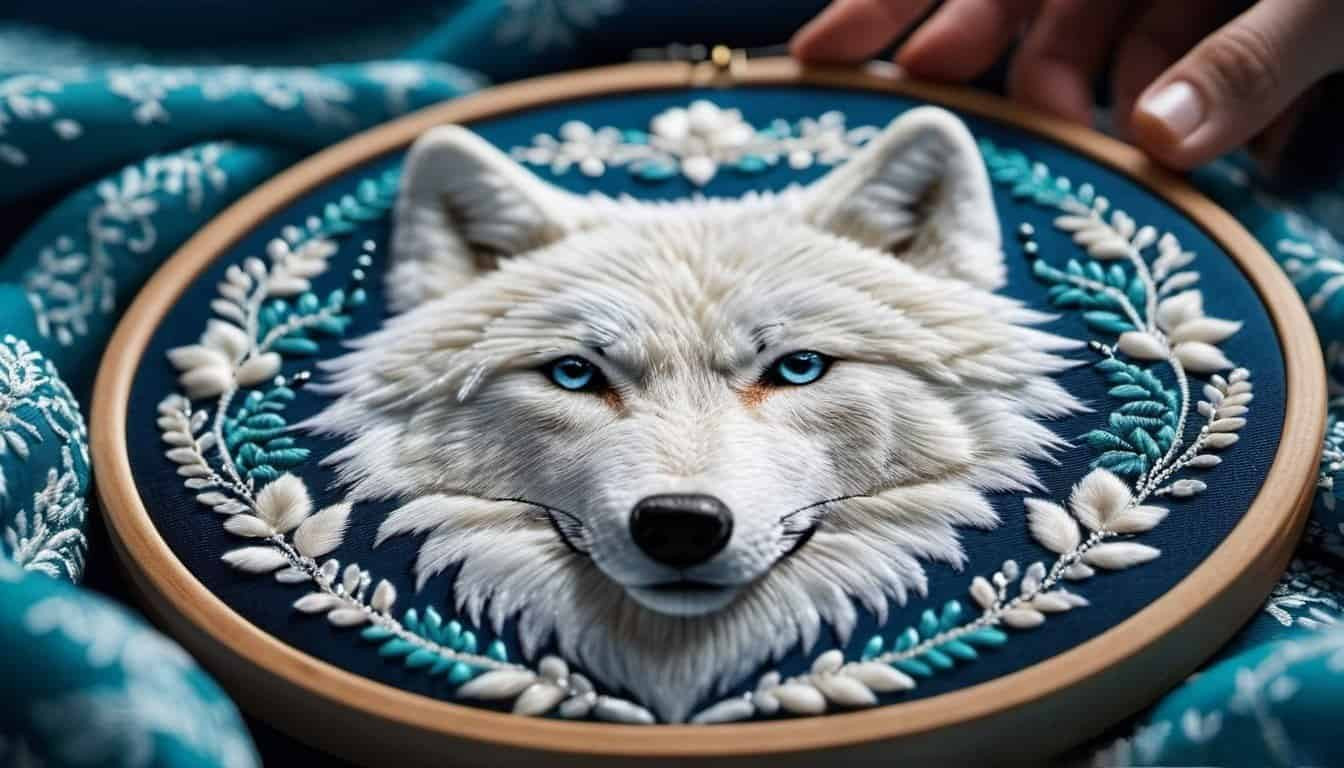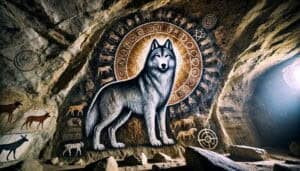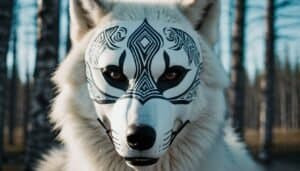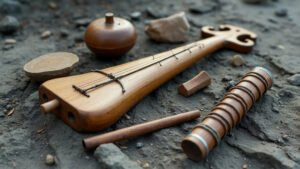Introduction
Arctic wolves hold a special place in the hearts of many Indigenous cultures, often symbolizing strength and endurance
This article explores how these majestic creatures are represented in Arctic embroidery and beadwork, focusing on the materials and techniques used, the cultural significance, and the unique patterns and designs
We will also highlight notable artists who have mastered the art of depicting Arctic wolves in their work, blending traditional methods with modern innovations
Materials and Techniques in Arctic Embroidery and Beadwork
Arctic embroidery and beadwork are rich in history and tradition, with methods passed down through generations
The depiction of Arctic wolves in these art forms requires a combination of traditional materials and modern innovations, showcasing the intricate techniques used to bring these majestic creatures to life
Traditional Materials and Techniques
Traditionally, Arctic embroidery and beadwork utilize materials that are readily available in the region. Natural fibers, animal hides, and sinew were commonly used by Indigenous artists. These materials provided durability and were integral to the crafting process
For example, caribou hides and sinew were often used as the base for embroidery, providing a strong and flexible surface for the intricate stitching of Arctic wolf designs
Porcupine quills and bone beads were also utilized, dyed using natural pigments derived from local plants and minerals. These traditional materials added texture and depth to the beadwork, allowing for detailed representations of Arctic wolves
The use of traditional stitching techniques, such as the lazy stitch and applique, were essential in creating the intricate patterns that define Arctic embroidery and beadwork
Modern Materials and Innovations
With the advent of modern technology and trade, the materials available for Arctic embroidery and beadwork have expanded
Today, artists have access to a wider range of beads, including glass and plastic varieties. These materials offer more vibrant colors and greater uniformity, which can enhance the visual appeal of the artwork
Synthetic threads and fabrics have also been introduced, providing more options for durability and flexibility. These modern materials allow artists to experiment with new techniques and styles while still honoring traditional methods. For instance, nylon threads are often used alongside traditional sinew, offering a balance of strength and ease of use
Modern innovations have also led to the incorporation of new tools, such as beading looms and embroidery machines. These tools help artists achieve greater precision and detail in their work, making the depiction of Arctic wolves even more lifelike and intricate
Embroidery Techniques for Depicting Arctic Wolves
Embroidery techniques play a crucial role in the depiction of Arctic wolves. Traditional stitches, such as the satin stitch and chain stitch, are commonly used to create the fur and facial features of the wolves
These stitches allow for a high level of detail and texture, capturing the essence of the Arctic wolf’s appearance
Artists often use a combination of stitches to create depth and dimension. For example, the use of split stitch for outlining and satin stitch for filling in areas can create a realistic representation of an Arctic wolf’s fur
Additionally, shading techniques, achieved by varying the thread color and stitch density, add to the lifelike quality of the embroidery
Beadwork Techniques for Depicting Arctic Wolves
Beadwork offers a different approach to depicting Arctic wolves, with a focus on pattern and color. The lazy stitch is one of the most common techniques used, where beads are strung and stitched in parallel rows. This technique allows for the creation of intricate patterns and detailed images of Arctic wolves
Another popular technique is the loom beading method, where beads are woven onto a loom to create a patterned fabric
This method is ideal for larger pieces and allows for precise, uniform designs. Bead embroidery, where beads are sewn directly onto fabric, is also used to add detail and texture to the representation of Arctic wolves
Artists often combine these techniques to enhance the visual impact of their work. For example, bead embroidery might be used to highlight specific features, such as the eyes or nose of the Arctic wolf, while loom beading provides the background or main body of the design
Symbolism and Cultural Significance of Arctic Wolves
Arctic wolves are not just prominent figures in the wildlife of the Arctic regions; they also hold significant cultural and symbolic meanings for Indigenous peoples
These majestic creatures are woven into the fabric of Arctic mythology, storytelling, and art, representing a range of virtues and embodying the spirit of the Arctic
Arctic Wolves in Indigenous Culture
In Indigenous cultures, the Arctic wolf is often seen as a symbol of strength, resilience, and survival
These wolves are admired for their ability to endure the harsh Arctic climate, which mirrors the challenges faced by Indigenous communities living in these regions. The Arctic wolf’s adaptability and hunting skills are seen as traits to be respected and emulated
Moreover, Arctic wolves are often featured in Indigenous legends and folklore. They are frequently depicted as guides, protectors, and symbols of family and unity. In some cultures, the Arctic wolf is believed to possess spiritual qualities, acting as a bridge between the physical and spiritual worlds
This deep cultural connection is reflected in the intricate embroidery and beadwork, where the Arctic wolf is a common motif
Storytelling Through Art
Embroidery and beadwork serve as powerful mediums for storytelling in Arctic Indigenous cultures
The depiction of Arctic wolves in these art forms is not merely decorative but is imbued with stories and meanings passed down through generations. Each piece of art can tell a story, whether it’s a legend about a wolf’s bravery or a narrative about the relationship between humans and wolves
These artworks often incorporate symbols and patterns that hold specific meanings
For example, a beaded representation of an Arctic wolf surrounded by certain symbols might tell a story about a particular hunting expedition or a significant event in the community’s history. The use of color, patterns, and placement all contribute to the storytelling aspect, making each piece a unique narrative
Evolution of Arctic Wolf Depictions
The depiction of Arctic wolves in embroidery and beadwork has evolved over time, reflecting changes in materials, techniques, and cultural influences
Traditionally, the representations were more abstract, using simplified shapes and patterns to symbolize the wolf. These early depictions focused on the essential qualities and spirit of the Arctic wolf rather than detailed realism
As contact with other cultures increased and new materials became available, the styles of depicting Arctic wolves began to change. Artists started incorporating more realistic elements into their work, using detailed stitching and beading to capture the likeness of the wolves more accurately. This shift allowed for a more nuanced portrayal of the Arctic wolf, blending traditional symbolism with detailed artistry
In contemporary times, some artists continue to honor traditional styles, while others experiment with modern techniques and materials. This evolution showcases the dynamic nature of Indigenous art, where the past and present coexist, allowing for a rich and diverse representation of Arctic wolves
Patterns, Designs, and Notable Artists
Arctic embroidery and beadwork featuring Arctic wolves are distinguished by their unique patterns and designs
These elements not only showcase the artistic skill of the creators but also reflect the cultural heritage and stories of the Arctic regions. Additionally, several notable artists have made significant contributions to this art form, blending traditional and modern styles
Common Patterns Featuring Arctic Wolves
Common patterns in Arctic embroidery and beadwork often incorporate the natural environment and other wildlife, creating a holistic representation of the Arctic ecosystem
Arctic wolves are typically depicted in dynamic poses, capturing their movements and behaviors in the wild. These patterns may show wolves howling, hunting, or interacting with other wolves, emphasizing their role as pack animals
Geometric shapes and repetitive motifs are also prevalent in these designs. For instance, triangles and diamonds might be used to represent the mountains and snow, while circular patterns could symbolize the moon or sun, elements closely associated with wolves in Indigenous stories
These geometric elements provide a structured backdrop that contrasts beautifully with the organic forms of the wolves
Color Schemes in Embroidery and Beadwork
The color schemes used in Arctic wolf embroidery and beadwork are often inspired by the natural hues of the Arctic landscape
Whites, grays, and blues are common, reflecting the snow and ice that dominate the region. These cool tones are frequently complemented by warmer colors such as reds, oranges, and yellows, which can represent the Northern Lights or the warmth of a community fire
Artists use color strategically to highlight specific features of the Arctic wolves and to draw attention to particular aspects of the design
For example, the eyes of the wolves might be depicted in striking yellow or amber to create a focal point, while the fur could be rendered in varying shades of white and gray to convey texture and depth. The choice of colors not only enhances the visual appeal but also adds layers of meaning to the artwork
Combining Traditional and Modern Styles
Many contemporary artists blend traditional and modern styles in their depictions of Arctic wolves. This fusion allows them to honor their cultural heritage while also exploring new artistic possibilities
Traditional styles might involve using natural materials and age-old techniques, while modern styles could incorporate synthetic materials and contemporary design elements
For example, an artist might use traditional stitching techniques to create the outline of an Arctic wolf but fill in the details with vibrant, modern beads that were not traditionally available. This combination results in a piece that is both rooted in tradition and reflective of the artist’s unique perspective
Some artists also experiment with abstract representations, using modern art techniques such as minimalism or surrealism to convey the essence of the Arctic wolf. These innovative approaches broaden the scope of Arctic embroidery and beadwork, bringing new dimensions to the art form
Renowned Artists in Arctic Wolf Embroidery and Beadwork
Several artists have gained recognition for their work in depicting Arctic wolves through embroidery and beadwork. These artists often draw from their cultural backgrounds and personal experiences, creating pieces that resonate with both traditional and contemporary audiences
One notable artist is Teri Rofkar, a Tlingit weaver known for her intricate baskets and textiles that often feature Arctic wolves and other wildlife. Her work combines traditional weaving techniques with modern designs, earning her acclaim in both Indigenous and mainstream art communities
Another prominent figure is Delina White, an Anishinaabe artist whose beadwork includes detailed representations of Arctic wolves. White’s work is celebrated for its vibrant colors and intricate patterns, which reflect her deep connection to her cultural heritage and the natural world
These artists, among others, have made significant contributions to the preservation and evolution of Arctic wolf embroidery and beadwork. Their work not only showcases their artistic talent but also serves as a bridge between past and present, ensuring that the stories and symbols of the Arctic continue to be shared and appreciated
Conclusion
Arctic wolves are a powerful symbol in Indigenous cultures, representing strength, resilience, and the connection between humans and nature. Their depiction in Arctic embroidery and beadwork is a testament to the rich artistic traditions of the Arctic regions
This article explored the materials and techniques used to create these intricate designs, from traditional sinew and natural fibers to modern synthetic threads and beads. The symbolism of Arctic wolves in Indigenous culture highlights their importance in storytelling and spiritual beliefs, while the evolution of their depiction reflects the dynamic nature of these art forms
Patterns and designs featuring Arctic wolves often incorporate elements of the Arctic landscape and other wildlife, using geometric shapes and natural hues to create visually compelling pieces
Notable artists like Teri Rofkar and Delina White have made significant contributions, blending traditional and modern styles to honor their heritage and bring new perspectives to Arctic wolf embroidery and beadwork
By understanding the cultural significance, artistic techniques, and the contributions of contemporary artists, we gain a deeper appreciation for the intricate and meaningful representations of Arctic wolves in these beautiful art forms











